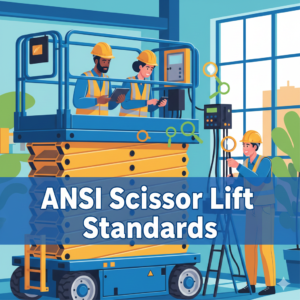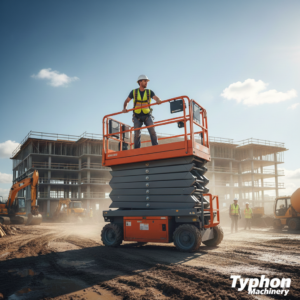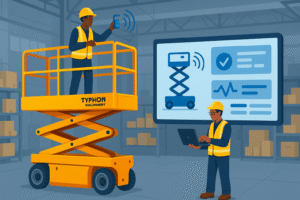Selecting the right scissor lift for your project might seem straightforward: use indoor models for indoor projects and outdoor models for outdoor tasks. However, various factors can influence your decision. This article explores the features, applications, and pros and cons of indoor and outdoor scissor lifts, guiding you in making an informed choice.
Indoor Scissor Lifts: An Overview
Key Features and Characteristics
Indoor scissor lifts are designed for use on smooth surfaces such as concrete, warehouse floors, and asphalt. They feature non-marking tires to protect indoor flooring and typically operate on electric power, using batteries that charge from standard 110-volt outlets. These machines often include safety features like pothole protectors, which are flaps that extend when the lift is raised above six feet.
Common Applications
Indoor scissor lifts are ideal for maintenance and service tasks including electrical work, plumbing, HVAC maintenance, and welding. They are also used in warehouses and retail spaces for lifting and retrieving merchandise, setting up displays, painting, and installing light fixtures.
Pros and Cons
Pros:
- Extendable platforms
- Capable of lifting multiple people and large quantities of materials
- Net-zero emissions
- Quiet, smooth operation
- Non-marking tires
Cons:
- Requires access to a charging station
- Limited to operation on level surfaces
- Vertical lift only, no horizontal reach
- Limited vertical reach and platform capacity
Outdoor Scissor Lifts: An Overview
Key Features and Characteristics
Outdoor scissor lifts, often labeled as “rough terrain” models, are designed for non-level, uneven surfaces. These machines are generally diesel-powered, although some electric models are available. They feature outriggers for added stability on rough terrain and have larger platforms that can hold more weight compared to indoor scissor lifts.
Common Applications
Outdoor scissor lifts are used for construction projects such as framing, installing road signs, bridge construction, window washing, and painting murals. They can be equipped with various attachments to enhance their functionality.
Pros and Cons
Pros:
- Larger platform capacity
- Greater vertical reach
- Suitable for non-level terrain
- Operates on rough, uneven surfaces
Cons:
- Higher operating expenses, especially for diesel models
- Potential for increased emissions
- Vertical lift only, no horizontal reach
- Not suitable for indoor use
Learn More: WHAT IS A HIGH CYCLE (HICY) SCISSORS LIFT?
Comparing Indoor and Outdoor Scissor Lifts
Working Height and Platform Capacity
Outdoor scissor lifts offer higher working heights and greater platform capacities than indoor models. Outdoor lifts can reach heights up to 70 feet and lift loads between 500 and 4,000 pounds, while indoor lifts typically have a maximum working height of 39 feet and can lift between 500 and 1,654 pounds.
Maneuverability and Mobility
Indoor scissor lifts are lighter, narrower, and more maneuverable, making them ideal for crowded indoor spaces. Their tighter turning radii allow them to navigate through double doors and narrow aisles. Outdoor lifts, being heavier and bulkier, are less maneuverable but excel in rough terrains.
Adapting to Terrain
Each type of scissor lift is optimized for its intended terrain. Indoor lifts work best on smooth, finished surfaces like tile and concrete, while outdoor lifts are designed for mud, dirt, sand, and other rough terrains. Indoor models have limited gradeability, whereas outdoor models can operate on sloped surfaces.
Power Source and Environmental Impact
Most indoor scissor lifts are electric, requiring access to power sources for charging. Outdoor models are predominantly diesel-powered, although some electric rough terrain models exist. Electric lifts produce net-zero emissions, making them environmentally friendly, whereas diesel models have higher emissions despite adhering to strict standards.
Operating Expenses and Maintenance
Electric scissor lifts generally have lower operating and maintenance costs compared to diesel models. Diesel engines have higher fuel and maintenance costs due to their complexity and fuel requirements. However, the batteries in electric lifts, while requiring minimal maintenance, can be costly to replace if they fail.
Selecting the Ideal Scissor Lift for Your Project
To choose the best scissor lift for your project, consider the following factors:
Job Site Conditions:
- Determine whether the site is indoor or outdoor
- Assess ground conditions and space for maneuvering
- Consider emissions restrictions and levelness of the surface
Required Platform Capacity and Vertical Reach:
- Ensure the scissor lift can handle the weight and reach required for the job
Project Budget:
- Compare the costs of purchasing or renting indoor versus outdoor scissor lifts
Learn More: A CLOSER LOOK AT SCISSOR LIFT TECHNOLOGY: ADVANCEMENTS AND FUTURE TRENDS
Indoor vs Outdoor Scissor Lifts Summarized
Both indoor and outdoor scissor lifts are versatile and efficient for various tasks. However, the job site conditions and specific project requirements should guide your choice. Understanding the differences in features, applications, and costs will help you select the optimal scissor lift for your needs.





